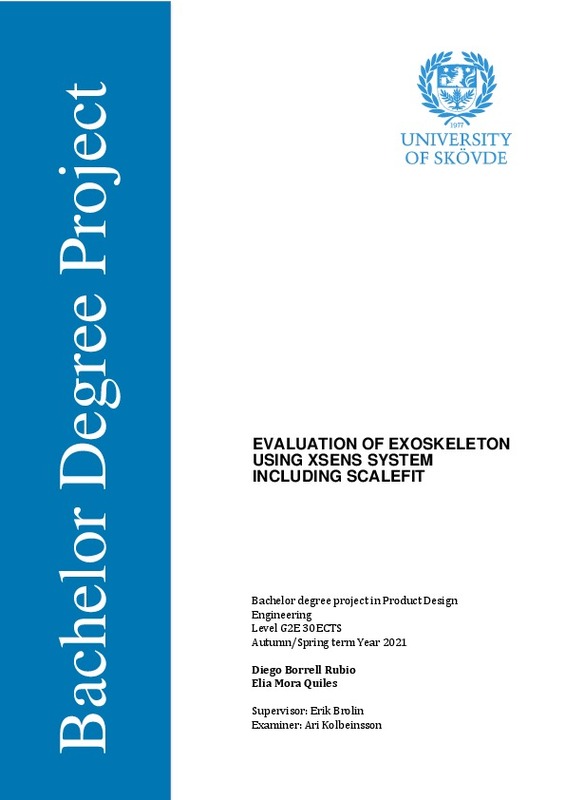|
Resumen:
|
[ES] Aunque el nivel de automatización en la industria del automóvil es actualmente muy alto, el factor humano sigue siendo necesario para las tareas de montaje, especialmente para las tareas por encima de la cabeza. Este ...[+]
[ES] Aunque el nivel de automatización en la industria del automóvil es actualmente muy alto, el factor humano sigue siendo necesario para las tareas de montaje, especialmente para las tareas por encima de la cabeza. Este tipo de trabajo provoca numerosas lesiones en los trabajadores de este sector, especialmente trastornos musculoesqueléticos (TME), siendo una de las principales causas de incapacidad laboral en los países desarrollados y, a su vez, convirtiéndose en un importante problema de salud. Con el objetivo de reducir este tipo de dolencias provocadas durante el desarrollo de este tipo de operaciones durante los procesos de montaje, actualmente se están barajando diversas opciones en las que se puede combinar la tecnología y el factor humano, entre las que se encuentra el objeto de estudio de este proyecto, un exoesqueleto.
El objetivo de este proyecto es estudiar los efectos biomecánicos, así como la ergonomía de un exoesqueleto pasivo denominado Paexo Shoulder, desarrollado por la empresa Ottobock, con el objetivo de aliviar las tensiones en las articulaciones del hombro y la parte superior de los hombros, durante su uso en tareas de montaje. Para ello, se diseñará un experimento en el que varios participantes realizarán una serie de tareas con y sin el exoesqueleto, de forma que se pueda observar los efectos de su uso y cómo afecta a los usuarios. Para ello, se diseñó un experimento para evaluar los efectos de la utilización o no de este exoesqueleto en 10 participantes al realizar una tarea similar a las que se encuentran en una cadena de montaje. Para la evaluación del producto se utilizó el sistema de captura de movimiento Xsens, en concreto el modelo Awinda, junto con el software ScaleFit para evaluar los resultados obtenidos a través de las grabaciones de captura de movimiento. Además, para mejorar las herramientas de DHM, se simuló la misma tarea con el software IPS-IMMA, cuyos resultados se analizaron posteriormente y se compararon con los resultados de la captura de movimiento mediante ScaleFit.
Los resultados mostraron grandes mejoras en la reducción del momento respectivo en la articulación del hombro al utilizar el exoesqueleto, sin embargo, también se observó que, debido a la fuerza ascendente ejercida por el exoesqueleto sobre los brazos, los participantes pasaron menos tiempo en las zonas de bajo riesgo evaluadas por ScaleFit y, por lo tanto, este efecto debe estudiarse más a fondo.
[-]
[EN] Although the level of automation in the automotive industry is currently very high, the human factor is still required for assembly tasks, especially for overhead tasks. This type of work causes many injuries in workers ...[+]
[EN] Although the level of automation in the automotive industry is currently very high, the human factor is still required for assembly tasks, especially for overhead tasks. This type of work causes many injuries in workers in this sector, especially musculoskeletal disorders (MSDs), being one of the main causes for inability to work in developed countries and, in turn, becoming a significant health problem. With the aim of reducing this type of ailments caused during the development of this type of operations during assembly processes, various options are currently being considered where technology and the human factor can be combined, among them we find the object of study of this project, an exoskeleton.
The aim of this project is to study the biomechanical effects as well as the
ergonomics of a passive exoskeleton called Paexo Shoulder, developed by the company Ottobock, with the aim of relieving tensions in the shoulder joints and upper part of the shoulders, during its use in assembly tasks. For this purpose, an experiment will be designed in which several participants will carry out a series of tasks both with and without the exoskeleton, in such a way that the effects of its use and how they affect the users of the product can be observed. For this purpose, an experiment was designed to evaluate the effects of the use or non-use of this exoskeleton on 10 participants when performing a task similar to an overhead task in an assembly line. For the evaluation of the product, the Xsens motion capture system, in particular the Awinda model, was used together with the ScaleFit software to evaluate the results obtained through the motion capture recordings. In addition, in order to improve DHM tools, the same task was simulated with the IPS-IMMA software, where the results were later analysed and compared with the motion capture results through ScaleFit.
The results showed large improvements in the respective moment reduction at the shoulder joint when using the exoskeleton, however it was also observed that due to the upward force exerted by the exoskeleton on the arms, participants spent less time in low risk areas evaluated by ScaleFit and therefore this effect needs to be studied further.
[-]
|







